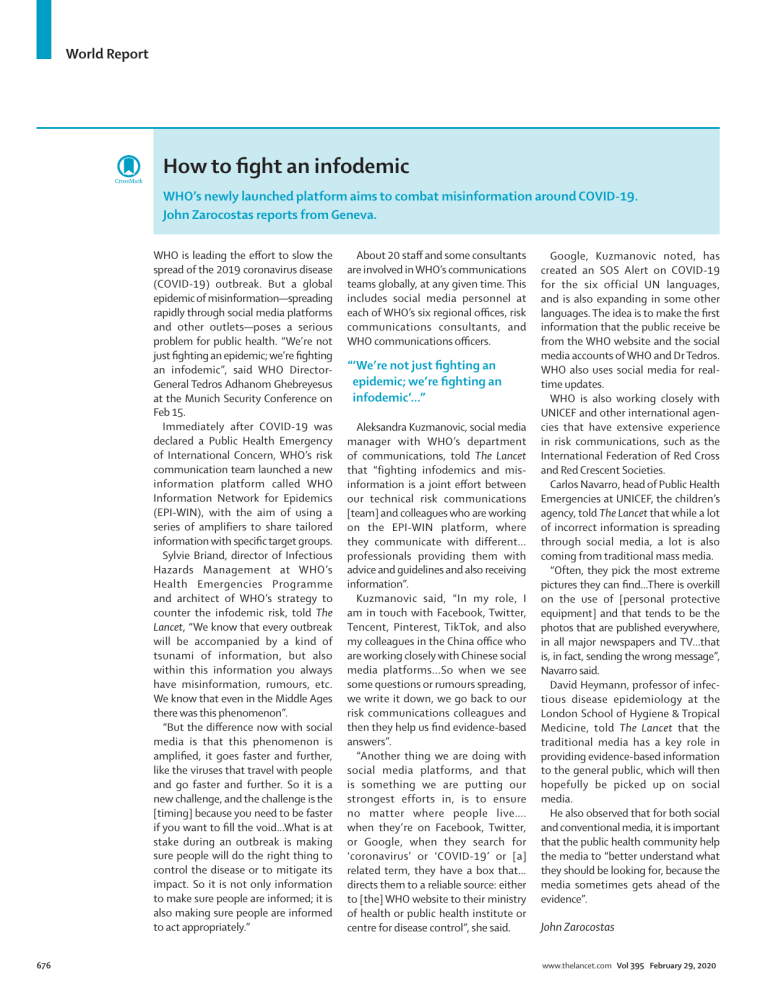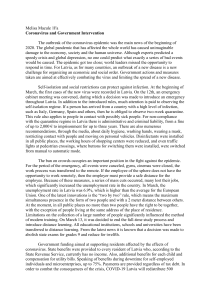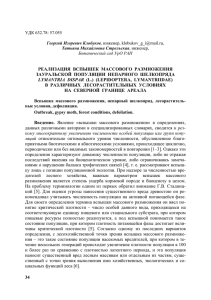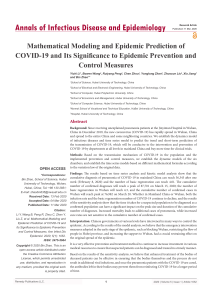
World Report How to fight an infodemic WHO’s newly launched platform aims to combat misinformation around COVID-19. John Zarocostas reports from Geneva. WHO is leading the effort to slow the spread of the 2019 corona­virus disease (COVID-19) outbreak. But a global epidemic of misinformation—spreading rapidly through social media platforms and other outlets—poses a serious problem for public health. “We’re not just fighting an epidemic; we’re fighting an infodemic”, said WHO DirectorGeneral Tedros Adhanom Ghebreyesus at the Munich Security Conference on Feb 15. Immediately after COVID-19 was declared a Public Health Emergency of International Concern, WHO’s risk communication team launched a new information platform called WHO Information Network for Epidemics (EPI-WIN), with the aim of using a series of amplifiers to share tailored information with specific target groups. Sylvie Briand, director of Infectious Hazards Management at WHO’s Health Emergencies Programme and architect of WHO’s strategy to counter the infodemic risk, told The Lancet, “We know that every outbreak will be accompanied by a kind of tsunami of information, but also within this information you always have misinformation, rumours, etc. We know that even in the Middle Ages there was this phenomenon”. “But the difference now with social media is that this phenomenon is amplified, it goes faster and further, like the viruses that travel with people and go faster and further. So it is a new challenge, and the challenge is the [timing] because you need to be faster if you want to fill the void...What is at stake during an outbreak is making sure people will do the right thing to control the disease or to mitigate its impact. So it is not only information to make sure people are informed; it is also making sure people are informed to act appropriately.” 676 About 20 staff and some consultants are involved in WHO’s communications teams globally, at any given time. This includes social media personnel at each of WHO’s six regional offices, risk communications consultants, and WHO communications officers. “‘We’re not just fighting an epidemic; we’re fighting an infodemic’...” Aleksandra Kuzmanovic, social media manager with WHO’s depart­ ment of communications, told The Lancet that “fighting infodemics and mis­ information is a joint effort between our technical risk commu­nications [team] and colleagues who are working on the EPI-WIN platform, where they communicate with different... professionals providing them with advice and guidelines and also receiving information”. Kuzmanovic said, “In my role, I am in touch with Facebook, Twitter, Tencent, Pinterest, TikTok, and also my colleagues in the China office who are working closely with Chinese social media platforms...So when we see some questions or rumours spreading, we write it down, we go back to our risk communications colleagues and then they help us find evidence-based answers”. “Another thing we are doing with social media platforms, and that is something we are putting our strongest efforts in, is to ensure no matter where people live…. when they’re on Facebook, Twitter, or Google, when they search for ‘coronavirus’ or ‘COVID-19’ or [a] related term, they have a box that… directs them to a reliable source: either to [the] WHO website to their ministry of health or public health institute or centre for disease control”, she said. Google, Kuzmanovic noted, has created an SOS Alert on COVID-19 for the six official UN languages, and is also expanding in some other languages. The idea is to make the first information that the public receive be from the WHO website and the social media accounts of WHO and Dr Tedros. WHO also uses social media for realtime updates. WHO is also working closely with UNICEF and other international agen­ cies that have extensive experience in risk communications, such as the International Federation of Red Cross and Red Crescent Societies. Carlos Navarro, head of Public Health Emergencies at UNICEF, the children’s agency, told The Lancet that while a lot of incorrect information is spreading through social media, a lot is also coming from traditional mass media. “Often, they pick the most extreme pictures they can find...There is overkill on the use of [personal protective equipment] and that tends to be the photos that are published everywhere, in all major newspapers and TV…that is, in fact, sending the wrong message”, Navarro said. David Heymann, professor of infec­ tious disease epidemiology at the London School of Hygiene & Tropical Medicine, told The Lancet that the traditional media has a key role in providing evidence-based information to the general public, which will then hopefully be picked up on social media. He also observed that for both social and conventional media, it is important that the public health community help the media to “better understand what they should be looking for, because the media sometimes gets ahead of the evidence”. John Zarocostas www.thelancet.com Vol 395 February 29, 2020



